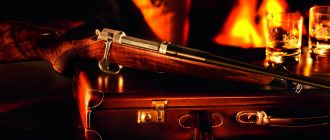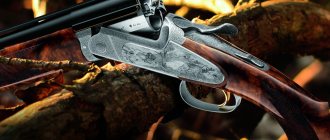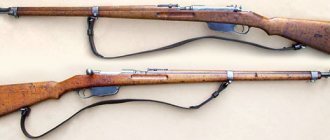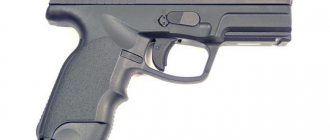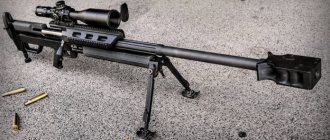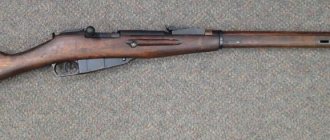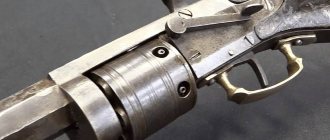Description of the Steyr Mannlicher Pro Hunter rifle
Bolt-action repeating rifle. A rotary forged barrel is a technology in which the rifling is formed simultaneously with the bore, resulting in spiral grooves remaining on its outer surface and making it appear twisted. Steyr Mannlicher deliberately leaves the barrel in this form as a signature feature of the brand.
Barrels can be non-reflective Mannox coated or made of stainless steel.
Another feature of the Pro Hunter series is the SBS 96 trigger control system. Its control element is a wheel on the butt plate of the receiver, which has three positions: Fire, Stop and Lock, in which the entire mechanism is deactivated and the rifle becomes completely safe.
A review of the Steyr Mannlicher Pro Hunter carbine is given in the video below:
Advantages and disadvantages
High quality manufacturing of mechanisms, barrels, stocks. The rifle can be considered a work of weapons art, although it has a completely utilitarian application.
- Excellent combat accuracy - the MOA value does not exceed 0.5, the ability to hit targets at distances of up to 400 meters (using optics). These qualities are achieved not only through precision processing of the barrel bore, but also by installing a chamfer on the muzzle, shaped like a torus, cut lengthwise.
- It is unpretentious in operation and does not require excessive attention. This is facilitated by a closed receiver, which prevents dirt from entering the mechanisms and the breech of the barrel.
- The SBS 96 trigger control system provides a high level of safety when handling weapons. In the Lock position, the bolt handle is wedged in the groove of the stock and does not cling to bushes during long treks. However, if you don't do this, you may lose the bolt, as this mode is used for partial disassembly to clean the weapon.
- The trigger mechanism is adjustable - the position of the hook and the stroke length change. The Pro Hunter rifle's trigger is crisp, with a short pull (idle). There is a sneller mode.
- The bolt has two pairs of lugs, the barrel locking is reliable, but it provokes a rather severe recoil, which is partially compensated by the massive shock-absorbing butt plate. Turning the handle just 60 degrees increases the rate of fire. The bolt stem moves in the receiver smoothly, with little effort, without jamming in extreme positions.
- The shape of the stock is convenient for both shooting from a rest and offhand. The forend has the shape of a trapezoid with a wide base. A bipod can be attached to it without any problems, and it holds just as well in your hands. There are no notches on the handle or forend, but the stock coating is rough, so there are no problems with grip reliability.
- A smooth deep recess is made between the butt and the handle. It may weaken the stock somewhat, but it makes it more comfortable.
- The use of impact-resistant plastic is more of an advantage than a disadvantage. This material allows the hunter to concentrate on the process of catching game and not particularly worry about the loss of the presentation of the weapon in case of blows and falls.
- The magazine has two positions: inserted normally, all the way, and also halfway, which allows you to close the bolt without chambering a cartridge.
- In addition to a set of external sighting devices - rear sight and front sight, on the receiver cover there are four mounting holes for brackets or rails for optics. Unfortunately, the rear sight and front sight are non-adjustable and are not equipped with fiber-optic threads. Although the range of the rifle makes their presence optional.
Steyr-Mannlicher ProHunter carbine (photo)
Purpose
The rifle is designed for hunting large game - grizzly bears, wild boars, adult male deer and elk. Firing range with optics is up to four hundred meters.
Varieties
In addition to the basic Pro Hunter model, which has a matte black stock, there is a Carbon option - an additional external coating with a light gray carbon fiber mesh that increases strength and grip. There is an option with a camouflage stock (Pro-Alaskan) and a pre-installed Picatinny rail.
The manufacturer offers two types of barrel finishing:
- black non-glare Mannox coating
- or pure stainless steel.
The Pro Hunter Elite variety stands somewhat apart, externally distinguished by the fact that these rifles are equipped with a long Picatinny rail, from the butt plate of the receiver to the front edge of the forend, supplemented by a tactical rail of the same type on the right side of the forend. Its trunk is thick-walled - match - 25.6 inches (65 cm) long. It is its cost that approaches a million rubles.
Specifications
STEYR MANNLICHER CL II Halfstock Standard STEYR MANNLICHER CL II Halfstock Magnum Caliber STEYR MANNLICHER CL II Mountain STEYR MANNLICHER CL II Semi Weight STEYR MANNLICHER CL II Fullstock STEYR MANNLICHER CL II Halfstock Stainless
caliber .243 Win., .308 Win., 7mm-08 Rem., 7×64, .270 Win., .30-06 Spr., .25-06 Rem., 6.5×55 SE, 8×57 JS, 9.3×62
overall length 1.110 mm, 43.7″
barrel-length 558 mm, 22″
weight ca. 3.5 kg, approx. 7.7lbs
magazine Detachable, synthetic magazine
magazine-capacity 4
trigger 2-stage trigger / forward set trigger / double set trigger
safety 3 position safety, Trigger safety, bolt handle and firing pin lock
stock European walnut, bavarian cheek piece with double flame and fish scale pattern
caliber 7mm Rem. Mag., .300 Win. Mag., .300 WBY., 8×68 S, .270 WSM, .300 WSM .375 H&H Mag.*
overall length 1.200 mm, 47.2 *1.150 mm, 45.3″
barrel-length 635 mm, 25″ *600 mm, 23.6″
weight ca. 3.5 kg, approx. 7.7 lbs *ca. 3.7 kg, approx. 8.2lbs
magazine Detachable, synthetic magazine
magazine-capacity 3
trigger 2-stage trigger / forward set trigger / double set trigger
safety 3 position safety, Trigger safety, bolt handle and firing pin lock
stock European walnut, bavarian cheek piece with double flame and fish scale pattern
caliber .222 Rem., .223 Rem., .243 Win., .308 Win., 7mm-08 Rem., 7×64, .270 Win., .30-06 Spr., 6.5×55 SE, 8×57 JS, 9.3×62
overall length 1.060 mm, 41.7″
barrel-length 508 mm, 20″
weight ca. 3.35 kg, approx. 7.45lbs
magazine Detachable, synthetic magazine
magazine-capacity 4
trigger 2-stage trigger / forward set trigger / double set trigger
safety 3 position safety, Trigger safety, bolt handle and firing pin lock
stock European walnut, bavarian cheek piece with double flame and fish scale pattern
caliber .308 Win., .30-06 Spr., 7×64, 8×57 JS, 9.3×62
overall length 1.070 mm, 42.1″
barrel-length 508 mm, 20″
weight ca. 3.8 kg, approx. 8.3lbs
magazine Detachable, synthetic magazine
magazine-capacity 4
trigger 2-stage trigger / forward set trigger / double set trigger
safety Trigger safety, bolt handle and firing pin lock
stock European walnut, bavarian cheek piece with double flame and fish scale pattern
caliber .222 Rem., .223 Rem., .243 Win., .308 Win., 7mm-08 Rem., 7×64, .270 Win., .30-06 Spr., 6.5×55 SE, .25-06 Rem., 8×57 JS, 9.3×62
overall length 1.070 mm, 42.1″
barrel-length 508 mm, 20″
weight ca. 3.5 kg, approx. 7.7lbs
magazine Detachable, synthetic magazine
magazine-capacity 4
trigger 2-stage trigger / forward set trigger / double set trigger
safety 3 position safety, Trigger safety, bolt handle and firing pin lock
stock European walnut, bavarian cheek piece with double flame and fish scale pattern
caliber .243 Win., .308 Win., 7mm-08 Rem., .270 Win., .25-06 Rem., .30-06 Spr., 6.5×55 SE, 7mm Rem. Mag.*, .300 Win. Mag.*, .270 WSM*, .300 WSM*
overall length 1.095 mm, 43.1″ * 1.200 mm, 47.2″
barrel-length 558 mm, 22″ *635 mm, 25″
weight ca. 3.5 kg, approx. 7.7 lbs *ca. 3.6 kg, approx. 7.9lbs
magazine Detachable, synthetic magazine
magazine-capacity 4 *3
trigger 2-stage trigger / forward set trigger / double set trigger
safety 3 position safety, Trigger safety, bolt handle and firing pin lock
stock European walnut, bavarian cheek piece with double flame and fish scale pattern
Description of the carbine Steyr Mannlicher AUG-Z A2
A self-loading carbine, the mechanisms of which are driven by part of the powder gases removed from the barrel when fired (gas engine). It has a bullpup form factor - the trigger is moved forward, it is located in front of the magazine. A special feature of the design is its modularity - with the press of one button it can be disassembled into three main blocks: the receiver, the bolt frame and the butt with the trigger mechanism.
To adapt to the requirements for civilian weapons, the rifle is deprived of the ability to fire bursts, and it also does not have a button for quick release of the barrel. Magazine capacity reduced from 30 to 10 rounds.
An overview of the Steyr Mannlicher AUG-Z A2 carbine is given in this video:
Advantages and disadvantages
- The bullpup form factor has made it possible to significantly reduce the dimensions of the carbine. So much so that the civilian version of the Z barely fits into the requirements of Russian legislation on civilian weapons.
- Debates about the advantages and disadvantages of weapons with a forward trigger among fans of firearms and air guns are ongoing. No common denominator has yet been found. In particular, it is believed that the displacement of the bolt group in the AUG-Z to the butt improves the accuracy of the battle, and it is more convenient for the shooter to transfer fire from one target to another.
- To a greater extent, the relatively good shooting qualities of the rifle are influenced by the fact that it has a rotating bolt cylinder with lugs. Models of submachine guns with a blowback mechanism - KSO-9 "Krechet", PPSh-0 - disperse bullets much wider.
- The weapon is equipped only with a Picatinny rail; it does not have a rear sight or front sight. The rail bracket is quite high, so those who are used to the classic stock position when aiming may find it somewhat uncomfortable.
- When creating the AUG, the goal was to replicate the reliability of the Kalashnikov assault rifle. Austrian engineers solved this problem only partially. The rifle is capable of firing when water enters the barrel and can withstand contamination by dust or sand. For this purpose, the gas engine has an adjustable channel cross-section. If it gets into liquid mud, the rifle jams. To resume shooting, you need to jerk the bolt frame again.
- The rifle has a large number of hidden cavities where dirt accumulates, and most of its parts are mated with very great precision. Therefore, it requires careful care. In field conditions, this condition is not always feasible.
The specific location of the magazine makes it difficult to replace it when shooting in a prone position. It itself is made of transparent plastic so that you can control it.
- There is a lot of plastic in the AUG design, even the trigger, except for the springs, is all made of it. This makes the weapon lighter, but subjectively it does not look reliable. At least from the point of view of Russian hunters.
- Even the use of plastic and aluminum does not make the weapon light, its weight is 3.6 kilograms. The .243 Win Browning Bar carbine, made of metal and wood, weighs the same.
Photo of Steyr AUG-Z/A2 carbine, .223 Rem
Purpose
To a greater extent, it is a weapon of self-defense. The relatively long barrel allows the AUG-Z rifle to be used for hunting at short distances. The target could be a fox, hare, wood grouse, or gilt boar. It is impossible to take an adult elk; the caliber is too large for hazel grouse and black grouse.
Varieties
In addition to the basic model based on the AUG A2, the AUG-Z A3 self-loading carbine and the AUG-Z A3 blowback submachine gun chambered for the 9x19 (Parabellum) cartridge are produced.
Advantages and disadvantages
In the Russian army it was customary to scold the Manhlir rifle. In inner circles it was considered good manners to criticize the shortcomings without noticing the strengths of the weapon.
In fact, it had enough advantages:
- High stopping power of the bullet.
- Sighting range – 1950 meters.
- High destructive power.
- Good rate of fire for its time - 50 rounds per minute, thanks to the direct action bolt.
- Excellent shooting accuracy, which made it possible to use the rifle as a sniper.
- Light bayonet and low weight.
- High maintainability and reliability. It was ideal for cavalry and infantry needs, as it could be repaired in an open field.
The disadvantages are related to the production time - there were no better weapons technologies then, even in Steyer . Now experts highlight the following disadvantages of the rifle:
- Trigger without "warning" movement. In general, at that time this was the norm.
- Inconvenient flag.
- Inability to reload the magazine. I had to shoot all the cartridges first.
- A tight shutter is a consequence of direct action. The standard mechanism on the Mosinka moved much easier.
Despite their shortcomings, testing during the First World War showed their survivability and reliability.
Shooting impressions
The staggered magazine is made of technopolymer. Its capacity is 4 cartridges. Durable and good quality, it does not deform the top of the bullet and facilitates the movement of the cartridge during the feeding stage
A bolt with an opening angle of only 60° and a stroke commensurate with the length of the cartridge, a convenient reloading handle that does not interfere with aiming, more than compensate for the worse sliding than that of the old “Mannlichers” and the previous Steyr L (standards of quality in this term). However, despite the extra friction created by the elastic ring, it is still better than many traditional name brand bolt bolters. This is largely due to the magazine, from which the cartridge comes out smoothly and without the slightest distortion. Easy to use, versatile and silent (except for the above-mentioned case), the fuse best combines safety and practicality when hunting. An aesthetic and comfortable buttstock with a Bavarian cheekpiece helps keep your head in the correct position. Despite the high quality of the wood, the weight of the carbine does not exceed 3,300 g, that is, it is not too heavy for running hunting and not too light for shooting. Ultimately, the Steyr Classic Mannlicher turned out to be a beautiful and high-quality weapon, having everything necessary for hunting - and above all, high combat accuracy. When testing a new carbine, it is necessary to keep in mind that the barrel has not yet been broken in and therefore is not able to show its best accuracy, and if a new weapon produces minimal dispersion, then its barrel is truly excellent.
Saddle-shaped rear sight for driven hunting. Leaning forward prevents glare
The above fully applies to the Steyr Classic Mannlicher, which, equipped with a Browning 3-9x50 optical sight, placed three 190 grain Hirtenberger Match bullets into a 20x15 mm rectangle at 100 m. Moreover, note that we are not talking about the distance between centers, but about the distance measured along the outer edges of the holes. The .308 Winchester cartridge has excellent accuracy, and you can easily get 1.5 MOA of dispersion from a good rifle. We fired five shots within 1 MOA with our carbine, and the Hirtenberger Match, RWS TUG, and Federal Premium cartridges performed even better at 0.75 MOA, 0.85, and 0.90 MOA, respectively. I would like to especially emphasize that as the barrel warmed up, neither accuracy nor accuracy deteriorated, despite its lightness.
The front sight, located on a high base, is height adjustable. The flat end facing the shooter is clearly visible
Based on materials from: Edisport Editoriale SpA
Operation and combat use
Austria and Hungary
Entered service back in 1886. Then, after the collapse of Austria-Hungary in 1918, the newly formed states took it into their arsenal.
Moreover, the rifle remained the main infantry weapon for a long time. Austria exploited it until the Anschluss with the Third Reich, after which the Mannhlir began to be used in Nazi Germany.
Bulgaria
After joining the Central Powers, the Austro-Hungarian State began supplying the rifle for infantry use in 1903.
Thus, until the end of World War II, the Menhlir remained the main weapon of the ground forces.
Greece
A relatively small number of ’95 carbines were also in service with Greece.
After occupation by the Third Reich they came into German possession and were renamed Gewehr 308.
Third Reich
The bulk of the rifles were received from the occupied territories. Moreover, in Germany weapons were not in wide demand.
Some of them were given to police departments, and as auxiliary weapons. Small quantities were delivered to the front, and some were completely given to Italy.
The only large-scale use of the rifle was in the Volksturm battalions. This is a formal people's militia, resisting anti-Hitler propaganda and agitation within the country.
7214 Mannlicher M95 rifles were given away as obsolete and unsuitable for the front.
Descent
The wide and comfortable trigger allows for excellent control of the descent, and the spacious trigger guard does not interfere even when shooting with gloves. The trigger of the
Classic Mannlicher carbine is very complex, but allows for a variety of adjustments. It is enclosed in a plastic case, attached to the receiver with two bolts. The escapement of our specimen additionally had a pin (also called a sneller); in the case of a direct trigger, its actuation force was 1,910 g (average value of five measurements). The breakdown of the whisper was clean and predictable.
The straight trigger is excellent, but if you want a very light trigger, simply moving the trigger forward is enough to cock the trigger and get a trigger pull of about 70g. Now you only need to lightly touch the trigger to fire, so some practice is required to fully master the shooting technique. The safety of some pins leaves much to be desired, which cannot be said about the pin of our carbine, which is impeccable from this point of view. To remove the pin from cocking, it is enough to move the fuse to the rearmost position (when the bolt is locked). If we set the safety to an intermediate position, in which only the trigger mechanism is blocked, the trigger is not removed from cocking, but even in this case, a spontaneous shot is excluded. The stem cannot be cocked when the bolt is locked, but this can be done in the middle position of the fuse, and it remains cocked even when the fuse is completely turned off. The wide, comfortable trigger allows for excellent trigger control, and the spacious trigger guard is comfortable even when shooting with gloves.
Description of the Steyr Mannlicher Luxus rifle
A bolt-action rifle with a detachable magazine. The barrel is made by cold rotational forging; spiral grooves remain on its outer surface; it looks as if it were twisted. This is a brand feature of all Steyr Mannlicher rifles.
A feature of the design is modularity. By unscrewing one screw on the forend, it and the barrel are removed. The owner can change the design of the receiver by choosing the style of the lining - wood, cupronickel, engraving.
The rifle has a luxurious design: selected types of wood are used, the surface of the metal parts is perfectly processed, the receiver is decorated with laser engraving. The weapon belongs to the elite category and costs more than half a million rubles.
An overview of the Steyr Mannlicher Luxus carbine is given in this video:
Advantages and disadvantages
Impeccable workmanship, well thought out ergonomics of the stock and the entire structure.
- The SBS 96 system is used - a three-position wheel on the neck of the butt that controls the trigger mechanism. It provides a high level of safety when using weapons.
- The modular design principle allows you to easily change barrels, and within the same group of calibers there is no need to change the bolt stem.
- The bolt received two additional pairs of lugs, as well as a rotating ring that overlaps the grooves in the breech when the cylinder is turned. Due to this, the locking density increased and the ballistic properties of the barrel improved.
- There are no plastic parts in the rifle, which are usually used in all Steyr Mannlicher models. For example, a trigger guard, a magazine, a wheel of the SBS 96 system. For lovers of the classics, this is a huge plus.
- A Picatinny rail is preinstalled, and there is a set of external sighting devices - a horizontally adjustable rear sight and a front sight, the height of which can be changed.
- The magazine has two positions - fully installed and extended halfway. This is convenient when deactivating a rifle in field conditions, because there is no need to remove the magazine to prevent a cartridge from being fed into the chamber.
- The trigger mechanism has a sneller mode; the stroke length and force on the trigger can be adjusted.
- The rifle can be adapted for people with a dominant left hand.
- The bolt stem fits very tightly into the grooves of the receiver. Its movement is smooth and without jamming in extreme positions. The shooter does not need to develop the skill of uniform movement when operating the bolt handle. However, the tight fit of the parts, even in ideal conditions - dry, relatively warm - makes it somewhat more difficult to move the bolt than, for example, on a Remington 700. In addition, if improper lubricant is used and it thickens in the cold, the bolt can be completely blocked .
- Ease of disassembly - to remove the barrel and fore-end it is enough to unscrew one screw, suggests that the design is not reliable enough, especially when using Magnum cartridges. Inevitable tolerances in the joints of the barrel and receiver will certainly affect the shooting performance of the rifle. With intensive use, it will most likely lose its sniper qualities.
Photo of the carbine Steyr Mannlicher - Luxus mod. 243
Purpose
This is a rifle primarily for running and driven hunting. When using optics, it is possible to hit targets at distances of up to 300 meters.
Varieties
In the standard version, the rifle's receiver has aluminum linings with laser engraving applied to them. The stock is made of regular grade walnut wood.
The following options for decorating the receiver are offered:
- wood plates;
- nickel silver overlays with hand engraving;
- cupronickel overlays with hand engraving and gold chasing.
In addition, the bolt handle can be made not in the form of a flat “tablet” with a convex edge, but in the form of a ball. Available with gold-plated trigger. The stock of optional models is made of “extra” class wood, which has an ornate natural pattern.
An overview of the characteristics of the Steyr Mannlicher Luxus is given below.
Operating principle
- The carbine uses part of the powder gases from the barrel to reload. Before you start shooting, you need to make sure that the gas piston regulator is in the correct position. If the weapon is clean and the quality of the ammunition is not in doubt, then its serrated lugs should be located opposite the small mark. Otherwise, they need to be moved to the larger one.
- Before loading, the weapon is put on safety - press the button on the left side of the receiver located above the rear branch of the trigger guard. To remove the magazine, press the button located at the rear of the hopper. The cartridges are stacked in the magazine in two rows. The magazine is installed in place with a characteristic click.
- An additional safety feature is the “shutter stop” position. To do this, the bolt handle is pulled back and rotated upward. So it hooks onto the protrusion on the receiver and holds the frame in the rearmost position, in which the firing pin is not cocked and the cartridge is not fed into the breech.
- Before starting shooting, the carbine is removed from the bolt stop, and the handle is sent forward with a slight push. During shooting, it is disconnected from the bolt frame and is always in the extreme forward position.
Shooting
from the Steyr Mannlicher AUG-Z A2 carbine is shown in the video below:
History of creation and production
The rifle was developed by gunsmith Ferdinand Mannlicher in the city of Steyr . In many ways, it differed little from the three-line series, which was released 3 years later. Same weight, similar trigger and approximately the same length.
However, there was one difference: a direct-action sliding trigger. When on a mosquito it was necessary to turn the stem to fire the cartridge and lock the barrel, all that was required was a back and forth movement.
Steyr Mannlicher, with just one modification of the bolt, was able to increase the rate of fire of the weapon, which was decisive on the battlefield at that time.
The M1886 model was immediately adopted by the Austro-Hungarian state. In 1888, a modification was released, and in 1890 it was a full-fledged carbine with an improved bolt and magazine box.
The rifle was finally formed in 1895 - Mannlicher M1895. The bolt is shorter and the barrel locking is stronger. The weight of the magazine was reduced, and the box was moved closer to the bracket. A wooden barrel guard appeared instead of a removable forend on the ring.
Around the same time, shortened modifications of previous rifles were adopted into infantry service.
Steyr Mannlicher SSG M1 sniper rifle, a modern continuation of the SSG 08.
In March 2018, at the Enforce Tac exhibition, a presentation of a new tactical modular sniper rifle with manual reloading and rotary locking from Steyr Mannlicher, the SSG M1, took place. Thus, the further development and vision of the future from a reputable Austrian manufacturer and the modern reincarnation of the SSG 08 sniper rifle were presented.
Unlike its predecessor (SSG 08), which is produced for four different calibers/cartridges, the Austrians decided (for now) not to introduce a large list of cartridges for the new one and settled on the two most popular - .308 Win (7.62x51 mm) and .338 Lapua Magnum (8.6x70 mm). The first is widespread, inexpensive and for short distances, the second is for medium (for sniper rifles up to 1500 m) distances, more accurate and more expensive. And, naturally, given the modularity, to switch from one cartridge to another, the necessary components are replaced.
For the .308 Win cartridge, two barrels of different lengths are produced - 508 mm and 635 mm, for the .338 Lapua Magnum - one, 690 mm long. The barrels are cold forged and free-floating. The receiver, forend, butt and stock are made of aluminum alloy (AFS). The upper part of the receiver and forend are manufactured with a Picatinny rail (MIL-STD-1913) with a slope of 30 MOA (minutes of arc), in addition, the forend at the 3, 6 and 9 o'clock positions is equipped with a more universal mounting interface - KeyMod. The stock has a wide range of horizontal and vertical adjustments and folds to the right side. SSG M1 rifle magazines for both cartridges, box-shaped, double-row, metal, 10 rounds, empty weight - 320 g. Trigger mechanism - 2-position, adjustable. Pistol-type grip with replaceable pads, a solution that practically copies the approach to adaptability of modern pistols.
The rifle is equipped with a muzzle brake and tactical silencer Ase-Utra (Finland), as well as a Kahles 6-24×56 K624i optical sight (Austria), an Aimpoint Micro T-1 collimator (Sweden) and an Atlas bipod from B&T Industries LLC, USA (not confused with B&T AG from Switzerland).
Rifle length in various variations: 338 Lapua Mag. (8.6×70 mm): With a 690 mm barrel and a folded butt – 1280 mm With a 690 mm barrel and a folded butt – 1080 mm
7.62×51 NATO: With 635 mm barrel and stock folded – 1225 mm With 635 mm barrel and stock folded – 1025 mm
With a 508 mm barrel and a folded butt – 1098 mm. With a 508 mm barrel and a folded butt – 898 mm.
Weight of a rifle with an empty magazine in various variations:
With a 690 mm barrel – 6.82 kg With a 635 mm barrel – 6.50 kg With a 508 mm barrel – 6.32 kg
Weight of the rifle chambered for .338 Lapua Mag. with optics and loaded magazine - 9.25 kg.
After the Precision Sniper Rifle tender was held in 2009 and the requirements were announced, it became more or less clear to manufacturers what the potential consumer needed. Offers poured in abundantly! Accuracy International AX 338, ArmaLite AR-30, Barrett MRAD (Multi-Role Adaptive Design), Blaser Tactical 2, Desert Tactical Arms SRS (bullpup design), FN Ballista, PGM 338, Remington Modular Sniper Rifle, Sako TRG M10. Remington won that market battle, the rest ended up in the army and special forces of different countries and with varying degrees of success. And the new Steyr SSG M1 rifle will have to compete on the market with another new product of 2018, the Sako TRG 22 A1/42 A1, which is a development of the TRG M10 model. We wrote more about the best large-caliber sniper rifles earlier.
Noteworthy is another presentation of the rifle, which took place in the city of Wiener Neustadt, Austria, on November 23, 2018. A special unit is stationed in the city of Wiener Neustadt - Jagdkommando, a special operations group of the Austrian armed forces, which ordered 120 Steyr SSG M1 sniper rifles at a cost of 1,600,000 euros. The ceremony was personally attended by the Minister of Defense of Austria, who officially presented the military personnel with Steyr-Mannlicher SSG M1 sniper rifles.
Design and principle of operation
Structurally, it is a rifle with a magazine and a sliding bolt type, the so-called. direct movement. The handle does not need to be turned counterclockwise/clockwise.
The bolt mechanism is cylindrical in shape with a pair of longitudinal grooves. They include the shank of the bolt head. Inside the cylinder there is a spiral entering the tail section. The bolt mechanism is easily disconnected: you just need to pull the trigger forward and disconnect the cylinder.
The trigger is normal. Like all rifles of that time, the Märklin is not equipped with a two-position hook.
The safety box is located to the left of the barrel. When raised up, it retracts the firing pin, preventing it from hitting the cartridge case.
The rifle is loaded with a pack of cartridges (always 5 pieces). When the entire magazine is fired, the cartridges fly out on their own under their own weight through the hole on the back side.
"Frame" type sight. It consists of a pipe mounted on a barrel with tin solder.
Separate sniper rifles with optical sights were also produced. A total of 6,000 pieces were produced for the needs of the army.
A bayonet was included with the rifle. Unlike the three-ruler, it was always worn separately, hooked onto the barrel only when necessary. It was useful in close combat, allowing you to parry with a rifle like a spear. It was fixed with a latch and did not require additional adjustment.

